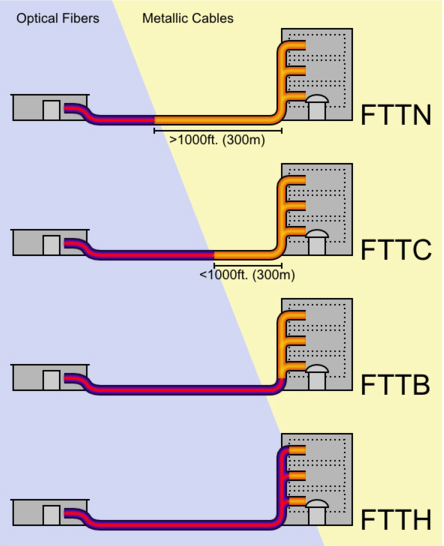Fiber to the x (
FTTx) is a generic term for any broadband network architecture using optical fiber to replace all or part of the usual metal local loop used for last mile telecommunications. The generic term was initially a generalization for several configurations of fiber deployment (FTTN, FTTC, FTTB, FTTH...), all starting by FTT but differentiated by the last letter, which is substituted by an
x in the generalization.
Definition of terms
The telecommunications industry differentiates between several distinct configurations. The terms in most widespread use today are:
-
FTTN - Fiber-to-the-node - fiber is terminated in a street cabinet up to several kilometers away from the customer premises, with the final connection being copper. Fiber-to-the-node is often seen as an interim step towards full FTTH and is currently used by telecoms service providers like AT&T, Deutsche Telekom, Telekom Austria, Belgacom and Swisscom to deliver advanced triple-play services.
-
FTTC - Fiber-to-the-curb / Fiber to the cabinet - this is very similar to FTTN, but the street cabinet or pole is closer to the user's premises; typically within 300m, within range for high-bandwidth copper technologies such as wired Ethernet and IEEE P1901 powerline networking, and wireless Wi-Fi technology.
-
FTTB - Fiber-to-the-building or Fiber-to-the-basement - fiber reaches the boundary of the building, such as the basement in a multi-dwelling unit, with the final connection to the individual living space being made via alternative means, similar to the curb/pole technologies, but also possibly shorter range technology like Thunderbolt.
-
FTTH - Fiber-to-the-home - fiber reaches the boundary of the living space, such as a box on the outside wall of a home.
-
FTTP - Fiber-to-the premises - this term is used in several contexts: as a blanket term for both FTTH and FTTB, or where the fiber network includes both homes and small businesses.
-
FTTD - Fiber-to-the-desk - fiber connection is installed from the main computer room to a terminal or fiber media converter near the user's desk.
 Benefits
Benefits
The speeds of fiber optic and copper cables are both limited by length, but copper is much more sharply limited in this respect. However, over the right kind of fiber, Gigabit Ethernet can easily reach tens of kilometers.
Even in the commercial world, most computers have copper communication cables. But these cables are short, typically tens of meters. Most metropolitan network links (e.g., those based on telephone or cable television services) are several kilometers long, in the range where fiber significantly outperforms copper. Replacing at least part of these links with fiber shortens the remaining copper segments and allows them to run much faster.
Fiber configurations that bring fiber right into the building can offer the highest speeds since the remaining segments can use standard Ethernet or coaxial cable. Fiber configurations that transition to copper in a street cabinet are generally too far from the users for standard Ethernet configurations over existing copper cabling. They generally use very high bitrate digital subscriber line (VDSL) at downstream rates of several tens of megabits per second.
Fiber is often said to be 'future proof' because the data rate of the connection is usually limited by the terminal equipment rather than the fiber, permitting at least some speed improvements by equipment upgrades before the fiber itself must be upgraded. Still, the type and length of employed fibers chosen, e.g. multimode vs single mode, are critical for applicability for future high gigabit connections.
